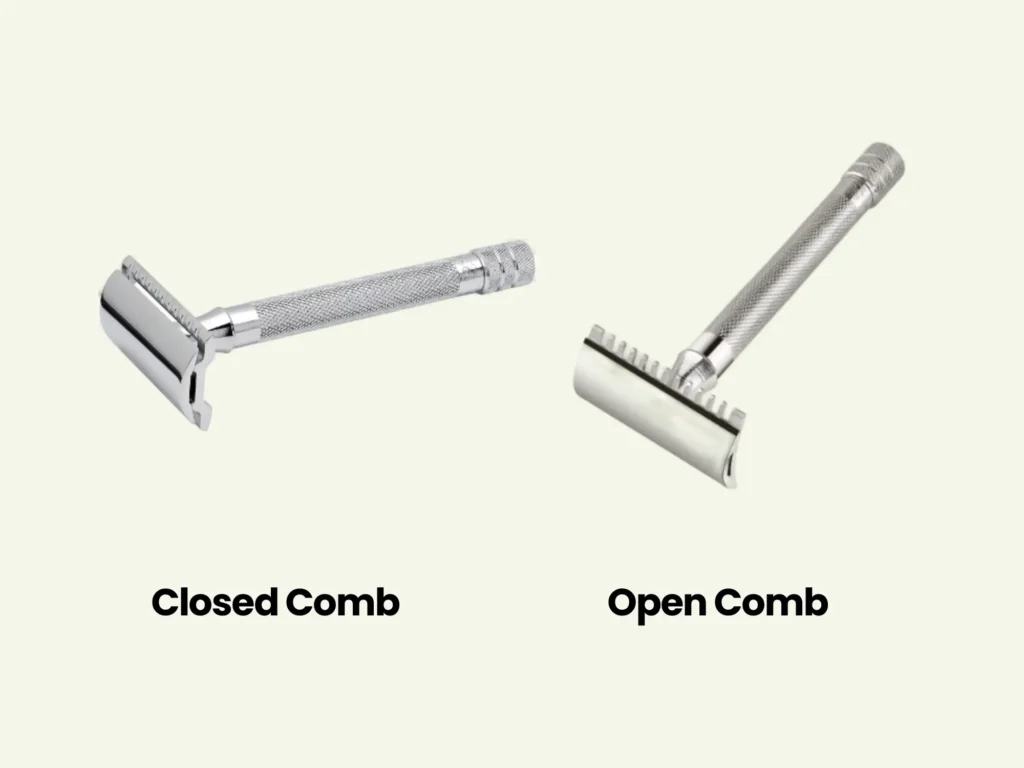There’s no denying that traditional wet shaving has made a resurgence in recent years, with many men opting for classic double edge (DE) safety razors for their grooming routine.
However, choosing the right safety razor can be a daunting task, especially when it comes down to the open comb and closed comb designs.
This comprehensive guide will help you understand the differences between these two types of safety razors, enabling you to make an informed decision based on your personal preference and skincare needs.
Key Takeaways
- Open comb and closed comb safety razors offer varying degrees of aggressiveness and shave closeness.
- Factors such as skin type, beard density, and personal preference can influence the most suitable razor choice.
- Understanding the pros and cons of each razor type can help achieve optimal shaving results and minimize skin irritation.
- Razor choice may depend on the individual’s comfort level and expertise in wet shaving techniques.
Pros & Cons of Both Razor Types
The table below summarizes the pros and cons of open comb and closed comb safety razors.
| Razor Type | Pros | Cons |
|---|---|---|
| Open Comb | – Efficient for thick/coarse beards – Closer shave – Less prone to clogging | – Higher risk of irritation – Steeper learning curve – Increased blade exposure (nicks/cuts) |
| Closed Comb | – Gentler shaving experience – Easier learning curve – Reduced risk of nicks/cuts | – Less efficient for dense beards – Slightly less close shave – Prone to clogging |
Understanding Safety Razors: A Deep Dive into Open Comb and Closed Comb Designs

Before diving into the differences between open comb and closed comb safety razors, it’s essential to have a basic understanding of each of these designs.
Open Comb Safety Razors
Open comb razors have a toothed or rake-like head, lessening the pressure on the skin, and bringing the facial hair closer to the blade. This will prevent the razor from clogging with shaving cream, oil, and other debris. This design provides more blade exposure, making it ideal for tackling coarse or thick facial hairs. However, they can be more aggressive and may require a bit more skill to use compared to closed comb variations.
Closed Comb (Safety Bar) Safety Razors
Closed comb razors feature a flat, rigged, or scalloped safety bar, which provides an additional layer of skin protection by limiting direct contact between the skin and the blade. This design is considered milder and is often recommended for beginners or those with sensitive skin.
The safety bar presses down on the skin, stretching it taut and lifting the hairs. This allows for a smoother and more comfortable shave.
The Differences Between Open Comb and Closed Comb Safety Razors
There are several factors that set open comb and closed comb safety razors apart, including aggressiveness, shave closeness, skin type compatibility, beard density considerations, and the learning curve involved.
Aggressiveness
Open comb razors are generally considered more aggressive due to their increased blade exposure. This can lead to a more efficient shave, but may also increase the risk of skin irritation and razor burn if not used with caution. On the other hand, closed comb razors offer a gentler shaving experience, with the safety bar reducing the chances of nicks and cuts.
Shave Closeness
When it comes to shave closeness, open comb razors generally provide a closer shave due to their more aggressive nature. This can be advantageous for those with thicker or coarser beards, although, there is some debate around this claim. However, closed comb razors also offer a satisfactory shaving experience, especially if proper shaving techniques, such as shaving with the grain and applying minimal pressure, are followed.
Skin Type and Beard Density
Open comb razors are usually more suitable for those with thicker or dense facial hair, as their increased blade exposure will cut through the hair effortlessly and provide a closer shave in fewer passes. However, they may not be recommended for individuals with sensitive skin, as the aggressiveness of the razor may cause irritation.
In contrast, closed comb razors are considered more beginner-friendly and generally better suited for those with sensitive skin or finer facial hair. While still capable of providing a close shave, the safety bar ensures minimal skin irritation.
Pro Tip: Regardless of the razor type, using a quality shaving cream, pre-shave oil, and post-shave balm can help reduce skin irritation and enhance the overall shaving experience.
Learning Curve
As open comb razors can be more aggressive, they typically demand a higher level of skill and shaving control. Proper shaving angle, razor balance, and adequate preparation are crucial to avoid nicks and cuts.
Closed comb razors, on the other hand, offer a more forgiving learning curve, making them suitable for beginners or those transitioning from cartridge razors.
In most instances, it is advised to practice with a closed comb razor first to establish proper shaving technique and get accustomed to handling a safety razor. Once you feel comfortable and confident in your skills, you may consider trying an open comb razor to experience a more aggressive shave or tackle denser facial hair growth.
So Should You Get an Open Comb or Closed Comb Safety Razor?
Ultimately, the choice between an open comb and closed comb safety razor depends on your individual preferences, beard density, and skin type. For beginners, sensitive skin, and finer facial hair, a closed comb razor might be the best choice. For more experienced wet shavers with denser or coarser facial hair, an open comb razor may offer a more efficient and closer shave. Evaluate your needs and comfort level, and be open to trying both types to find the most suitable option for your unique shaving experience.
I got a Vikings Blade Emperor for Christmas. It has an open comb on 1 side and closed on the other. It does make for an interesting shave. First pass on a section with the open, flip and do a finish pass.